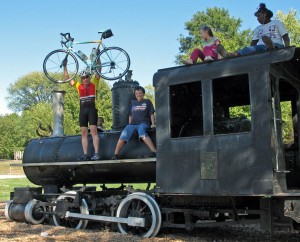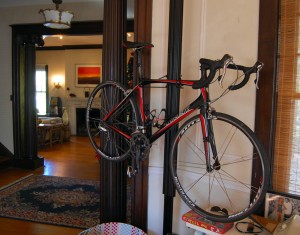St. Louis Bro Mark, showing little respect for his older brother, wrote, “You seem to have plenty of time on your hands now that you are retired. Here is my question: Nitrogen in bike tires. Good, bad, indifferent?”
In the springtime, a young man’s thoughts turn to biking. Of course, this isn’t springtime in the Midwest and Mark has been freed for several years now of the danger of dying young. That’s why Bro Mark’s Trek Madone is serving as a piece of hanging art in his dining room.
Despite his obvious mockery, I did a little research.
One of the advantages of being older than dirt is that (A) we didn’t have much history to learn because not much had happened yet and (B) the Periodic Chart of Elements was really short because most of them hadn’t been discovered.
Nitrogen – the Cher of elements
Nitrogen, was Atomic Number 7, and was one of the Cher of elements, needing only one letter in its symbolic name – N – unlike nouveau elements like Ununoctium which is so new that it still has a temporary name and a three-letter symbol, Uuo.
To geek out even more, “Nitrogen is a common normally colourless, odourless, tasteless and mostly diatomic non-metal gas. It has five electrons in its outer shell, so it is trivalent in most compounds.
So, does it make sense?
Here are some reasons given for using Nitrogen:
- Some dealers give you cool green valve stem caps to signify that the tire is filled with N. (I guess you could just swipe two caps and put them on your tires to make people THINK you are cool.)
- It eliminates moisture. That could prevent rusty rims in car tires, but your air is sealed inside rubber inner tubes.
- Nitrogen makes up about 78% of the atmosphere, Oxygen about 21% and other gasses, about 1%. That 1% varies depending on whether or not someone in the vicinity of the tire pump had Mexican for lunch or you’re standing in a field near Methane-producing cows. Nitrogen molecules are bigger than Oxygen molecules, so they sneak out through the pores of your rubber inner tube more slowly.
- Because the gas is dryer than normal compressed air, the density of the gas remains more constant, especially at temperatures higher than 100 degrees. Now, that’s probably more of an issue if you’re a NASCAR driver, but I’ll concede that a blacktop road surface on a July day COULD reach more than 100 degrees.
- Because Nitrogen is inert, it doesn’t attack the rubber in your tubes like Oxygen does. I generally wear out my tires and tubes from the outside in, so I’m not sure how much a benefit this is.
- Nitrogen doesn’t support combustion. That’s why it’s used in commercial aircraft tires and the Space Shuttle. A Boeing 727 with an air-filled tired crashed after an overheated landing gear brake set the tire on fire, killing 167 passengers in 1986. Somehow or another, I don’t think you hit speeds high enough to make this a concern.
- Since it doesn’t support combustion, it also doesn’t support life. That means that if your car runs off the road into a canal and you reach for your bike tire in the back seat to provide you with enough air to escape, you’re dead.
- But, and I’m sure that this is the biggest reason that you would make a switch, Nitrogen is lighter than air. The difference is about an ounce in a car tire, so I suspect that you could spit at the start of a climb and deduct about as much weight as you’d save by converting your bike tires to Nitrogen.
 The major drawback for you
The major drawback for you
I’ve observed that your bike is so light that you often have to chase it down to keep it from flying away, as documented in this picture taken at Cape Girardeau’s Capaha Park. If it got it any lighter, it could slip away from you and become a UFO. Homeland Security will NOT be amused.


First, thanks for at least approaching this question with some earnest. I think it does go to show you DO have a lot of extra time on your hands and how perhaps you should devote some of that time to riding your new magic bike. Please read that with the same love you projected in your answer to my nitrogen quest.
Second, doesn’t that plastic bike of mine look good? Read that as you might have a new bike, but take a look at mine and drool a bit.
Third, sadly the photo on the train hoisting the bike is my old Bianchi that Matt is now racing around town. But please take a gander at the kids on top of the train, they seem impressed.
Finally, it appears I will NOT be topping off my tires with nitrogen anytime soon, although I am somewhat sadden that I will have to regularly put air in the tires when I ride it. That pump thing is time consuming when I just want to hit the road and ride…. Read that as I am not retired and don’t have as much free time as you do.
It would appear that there is no shortage of hot air in St. Louis.
Just think of the pump thing as being a pre-ride warmup exercise.
Just how prevalent are nitrogen pumps? Once you begin using it, I presume there’s no harm in mixing the two once you get started.
Otherwise, in those cow towns Mark rides, he might have to carry that air pump with him.
It’s a wonder Mark hasn’t tried helium, being so light-headed.
There’s no harm in mixing compressed air and Nitrogen, except that it’s no long pure nitrogen.
Finding a place to top off shouldn’t be hard. I think Costco and Sams offers nitrogen and so will a lot of small tire dealers. It’s a profitable business for them.
Whether they could deliver it to a high pressure bike tire in the 100-110 psi range, I don’t know. I also don’t know what they’d charge.
I’ve read that helium isn’t good for tires, but I don’t recall why.
I had no bloody idea nitrogen had so many advantages. Thanks for the research, Ken.
Nitrogen is now at the top of my MUST HAVE items list. Surely Amazon.com must have a bicycle pump that filters out the bad stuff – the oxygen and methane and other impurities – and delivers only pure nitrogen to your tube.
And the little green caps. I MUST HAVE those little green caps…
I think the bigger question is should you leave CO2 in your tires after fixing a flat.
The molecular weight of CO2 is 44.01 while the molecular weight of nitrogen is 28.013. The weight difference is non-trivial.
Given that most of what we slurp into our lungs in good old fashioned American air is nitrogen, the molecular mass of dry air is 28.97.
At nearly twice the weight (at sea level, all else being equal), I make sure to flush the CO2 out of my tires as soon as possible and replace it with either regular air or nitrogen.
—Matt
Matt,
Gee, being at sea level apparently all things aren’t equal compared to Missouri “river level” because a flat here is F-L-A-T. If there was something left in my flat tires to ride on, a.k.a. CO2, I’d ride em till the rims sparked.
And while there is some debate as to how much hot air weighs (no shortage of that here in St. Louis as oldest brother already noted) I have yet to see a photo of YOU hoisting the Bianchi in the air after/during a ride. What gives? Did the bike become heavier when I shipped it to you from Missouri to Florida? Does being at sea level (all else being equal) make a difference?
You could blame it on the amount of salt water in the air as compared to the amount of just plain humidity here in St. Louis, but in my non-scientific way I discovered where a gallon of water here weighs 8 lbs. and gallon of salt water there weighs in at 8.5 lbs. Please, before you get your density calculator out and start punching buttons, I carefully took into consideration the amount of salt in the Atlantic ocean as compared to the Dead Sea…and my calculation has a temperature +/- variance of 20 Fahrenheit degrees.
Matt isn’t able to lift the Bianchi in the air like you did because of the lead weights you slipped inside the frame before you shipped it to him.
Sort of like the extra two bottles of water I found hidden in my panniers when I rode with you, Matt and Wally in Illinois on the Full Moon Ride.
http://www.palmbeachbiketours.com/2008/06/22/dont-let-anything-come-between-you-and-your-bike-shorts/
I lift the Bianchi after every ride, even if it is just a quick jaunt to the grocery store and back. The problem is, I can’t get anyone to ride with me to take the pictures.
Adam isn’t willing to get up before two in the afternoon to ride and thus I never see him. I don’t have the arm strength to hold the bike above my head for two or three hours while I’m waiting Dad to catch up, finish and photograph.
My bike riding uncle had the perfect opportunity to take a picture of my hoisting the bike at last year’s MS-150 but failed in that duty. If I can get him out of his winter cave and on the road, maybe he’ll get another chance.
—Matt
“Some dealers give you cool green valve stem caps to signify that the tire is filled with N. (I guess you could just swipe two caps and put them on your tires to make people THINK you are cool.)”
I had no idea there was a reason for the green valve caps.
Thanks for the tip about CO2 Matt. Something that I can use for sure!
After reading your article on Nitrogen in bike tires, I decided against filling my tires with Nitrogen, a choice that saved my life when I rode my bike into the canal near my home. I could of just floated to the top, but buddy breathing from the presta valve stem gave me time to hide long enough before surfacing to avoid the embarrasment of any witnesses. Don’t attempt with shraeder valves. So thanks again for the great advice.